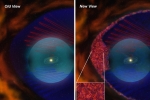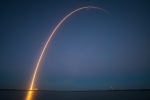Scientists Demonstrate Three-Way Quantum Communication: What's Faster Than The Speed Of Light?

Scientists say they have proven, for the first time, that quantum communication can connect multiple parties, like a three-way phone conversation. Except much, much faster.
Like Us on Facebook
Quantum technology, still largely theoretical, employs the natural properties of particles smaller than an atom for things like computing and cryptography. Many subatomic particles have polar qualities — like up or down, on or off — that can be understood and translated into useful information. In findings published Sunday in Nature Communications, an international team of researchers wanted to know if they could use the properties of light particles to send data in multiple directions over vast distances — at faster than the speed of light.
Back in the 1930s, as physicists were first describing quantum mechanics, Albert Einstein didn't believe this kind of communication was possible. He described it as "spooky action at a distance." How could anything be relayed faster than the speed of light?
To prove his point, he developed a thought experiment dubbed EPR. In it, he describes a pair of particles linked in space-time, a phenomenon later called "entanglement." Entangled particles would respond to each other no matter their physical distance; a photon entangled with a negative photon would always simultaneously be positive. For Einstein, this was impossible under his theory of relativity.
But by the 1960s, physicists were increasingly convinced of quantum mechanics and its propensity to flout the traditional rules of physics. Entanglement was possible, they said. But not until recently have scientists begun to demonstrate it. Last year, for example, researchers at the University of Science and Technology in Shanghai measured how fast "simultaneous" really is. They set up two entangled photons 10 miles apart, then observed how fast a change of state in one would register in the other. The result, according to their paper, was 10,000 times the speed of light.
The team of scientists in the new study wanted to one-up them by entangling three photons. "Three-particle entanglement is more complex than that of pairs," said co-author Kevin Resch, of the University of Waterloo in Canada, in a statement. "We can exploit the complex behaviour to rule out certain descriptions of nature or as a resource for new quantum technologies."

In the experiment, they connected fiber optic cable to trailers more than 2,000 feet apart and away from the rooftop of their Canadian laboratory. The trailers contained detectors that could sense the entangled photons and timestamp the moment of their state change down to within three nanoseconds to preserve the integrity of the experiment. No other signal except the chatter of entangled particles could travel that quickly. And according to their paper, it worked. They called the demonstration a "milestone" in quantum mechanics.
"We now have the ability to do more than paired quantum communication," said lead author Chris Erven, of the University of Bristol, in a statement. The researchers say they could use this new ability to distribute quantum keys — which unlock encrypted data — or for "quantum secret sharing." According to Erven, "This is the first experiment where you can now imagine a network of people connected in different ways using the correlations between three or more photons."
Top photo courtesy of Shutterstock
© 2012 iScience Times All rights reserved. Do not reproduce without permission.

25 Year Study Reveals Eco-Farming To Be Economically Feasible And Sustainable

How Methane-Producing Microbes Caused The Largest Mass Extinction The World Has Ever Seen

Terrifying Animatronic Robot Dances To 'Blurred Lines,' Causes Nightmares [VIDEO]

Scientists Demonstrate Three-Way Quantum Communication: What's Faster Than The Speed Of Light?

Woolly Mammoth DNA To Be Cloned, Then Joined With Elephant DNA To Create New Creature

Oculus Rift Headset Will Take You On A Trip To Space, All From The Comfort Of Your Couch



![How to Turn Your Tap Water Faucet Into a Coffee Spout [VIDEO]](../../../cdn-sub/data/thumb/mainpage/6005-150100-coffee.jpg)

